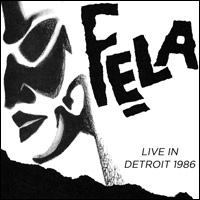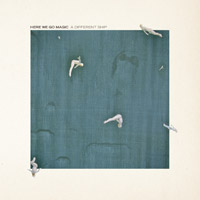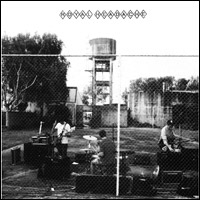
Live in Detroit, 1986
Knitting Factory
Even after having put the dozens of records in the Fela Kuti catalog back into print, Knitting Factory Records’ latest addition to the Kuti discography represents a particularly special milestone. Live in Detroit, 1986 is the first new Fela recording to be released in 20 years, and the record captures him on what was probably, if I’m not mistaken, his last US tour.
As is to be expected, the double-album is comprised of only four songs, each clocking in at between 29 and 40 minutes. As such, each cut morphs several times over, progressing not so much linearly, but in a circular pattern so that each composition returns to previous motifs repeatedly even as it is spirals outward. None of the songs had been released prior to this recording; “Just Like That” and “Teacher Don’t Teach Me Nonsense” would appear on an album of the same name as the latter later in ’86, while “Beast of No Nation” wouldn’t be pressed to wax until ’89 and “Confusion Break Bones” wouldn’t appear until 1992 on Underground System.
Playing with Egypt 80, Kuti flits between bellowing sax solos, funky free-flowing keys and his commanding vocals. While the performance isn’t as powerful as the heavy funk captured earlier in his career (like the VIP recording of his performance at the 1978 Berlin Jazz Festival), it is fascinating in its revealing of Fela and his band’s organic progression into something more fluid. The recording itself is somewhat lacking, with too little low end and lingering tape noise. Nonetheless, when Kuti and Egypt 80 really get going, as on the closing “Beast of No Nation,” the power of his music is unmistakable.
Stephen Slaybaugh

Wallpaper Music
In the Red
Not content to merely cycle through a bunch of Ramones riffs and call it a day, Jeffrey Novak has brought a heightened sense of songwriting and experimentation to his version of hook-filled punk and garage. With his solo work, Novak pays homage to iconoclastic solo artists such as Kevin Ayers and John Cale, and though Cheap Time is a much more aggressive endeavor, the band is likewise a showcase for Novak’s distinctive musical idiosyncrasies.
On its self-titled debut, Cheap Time was very much a loud, fuzzy punk band that blared out bratty glam and power-pop melodies. There were glimpses of Novak’s potential for eccentricity via the occasional analog squiggle, but it was a more or less straightforward endeavor. On the band’s third full-length, Wallpaper Music, Cheap Time has solidified as a unit and fully integrated Novak’s various tastes and influences into a final product wherein the sum is very much greater than the parts.
On Wallpaper Music, Cheap Time is still rooted in the basics: punk, power-pop, and glam. Tracks such as “Another Time” and “Night to Night” are tough rockers that spotlight the trio’s ability to play it straight and throw a punch to the gut if necessary. Other tracks are more unconventional, though. “Straight and Narrow” is a glittery sci-fi number built on a martial cadence and a ray-gun guitar. “Dream It Up” starts off with a rickety drum-machine beat before exploding into a Hawkwind-like stratosphere. “Take It If You Want It” is a jangly, jaunty pop tune that displays Novak’s love for quirky British songwriters and is perhaps the catchiest song on the album. “Underneath the Fruit Flies,” a dark, gnarled seven-minute-plus workout, closes out the album and works as the perfect unsettling ending to a curious record.
Novak, though possessed of one of the most deliriously snotty voices out there, is smarter than your average punker, and Wallpaper Music is hard evidence of that fact. Like his friend and fellow rocker, the late Jay Reatard, Novak hasn’t let his chosen genre pen in his abilities as a songwriter. The instrumentation alone here includes piano, organ, flute, kazoo and stylophone, and shows Novak’s restlessness and his sense of possibility. The songs reference any number of styles, but the album has cohesion and never feels like a kitchen-sink gimmick. The melodies are at once catchy and familiar but twist and turn go in unexpected directions. And all this on a mere “punk” record. That’s talent. And in using his talent in this way Novak transcends whatever category Cheap Time gets lumped into and stands firmly on his own as an artist.
Nate Knaebel

Dr Dee
Virgin
When a multi-faceted band like Blur dissolves into solo entities, judging those post-band efforts allows us to easily theorize retrospectively about which member had influence on which chorus or verse or song or album throughout the body of the band’s work. Seeing as founding members,Graham Coxon and Damon Albarn met at conservatory school, it’s not surprising that the band could jump musical genres so skillfully and convincingly to a point where the weirder side of Brit-pop grew out of their experimentation.
Revisiting Blur albums is much more rewarding than the initial listens; for some reason their album cuts had a quality that would only reveal itself over time. Perhaps this was because these songs had more of Albarn’s drama-inspired influence and less of Coxon’s guitar-driven focus. Or maybe because that recorded synergy has grown into a whole new entity detached from either songwriter. Almost in continuation of the evolving style of Blur, Albarn has spun off on his own tangent with wildly disparate collaborative projects like The Good, the Bad, and the Queen, Rocket Juice & the Moon (in progress, with Flea, of all bassists), Gorillaz, and now a co-writing credit with director Rufus Norris for Dr Dee, an “English Opera” featuring the BBC Philharmonic and the greatest drummer who ever lived, Tony Allen. The opera tells the story of John Dee, a Renaissance-era mathematician and adviser to Elizabeth I, who, by association with charlatan occultist Edward Kelley, was saddled by the end of his life with a reputation as a crank alchemist and Rosicrucian cabalist who blew smoke about chatting with angels until he died in poverty and disdain. The story is interesting enough in itself without the music, but leave it to Damon Albarn to actually be capable of creating a worthy soundtrack. Just don’t expect “Song #2” or “Parklife.”
“The Marvelous Dream” and “The Dancing King” may be the only capital P pop songs on the record, and just barely so. I would be very surprised if any of these songs garnered radio play during even the overnight shifts. This is not to say Dr Dee is without incredibly beautiful songs, it’s just the opposite. The music is too perfect and too well done to find itself anywhere outside of the cool Britannia-phile’s record collection or the Manchester International Festival for which it was conceived. Creepy choral voices and distant church bells make up one song (“Tree of Beauty”), and another is just drums, maybe a conventional rock kit and a Bodhrán in a strange Afro-Anglo fusion (“Preparation”).There’s some ostentatious lute and recorder stuff here that I’m not sure I’ll be able to listen to when I’m with company, but there’s also a freaked-out, dissonant organ and bird-chirp song called “The Golden Dawn” (no connection with the Greek Golden Dawn) that would only benefit from being blasted from the third floor window to a crowded street below. Dr Dee may be the most challenging listen Albarn has created thus far. While I’m completely sure that just listening to the music without watching the actors leaves holes in the experience, there’s enough here to fill a head with imagery and a few songs that are for keeps.
Michael P. O’Shaughnessy

A Different Ship
Secretly Canadian
Here We Go Magic began life as the folktronica offshoot of Luke Temple. After releasing one album as a solo act, Temple rounded up some like-mined bandmates and signed up with the Secretly Canadian label. The full band released it’s coming-out album, Pigeons, in 2010, with an EP following the subsequent year. Now they’ve regrouped for the proper follow-up, A Different Ship.
While iTunes’ classification might place Here We Go Magic squarely into the indie rock category, the band actually has a little bit more going on than your meat-and-potatoes band usually does. It’s not like they’re trying to reinvent the wheel, but there’s a lot of subtle distinguishing factors. Harmonies and melodies are layered so slowly that the listener may not even notice until they’re knee-deep in a very lush arrangement. There’s a bunch of moving parts, but they move together seamlessly. The album does get a bit lost in the moment during the last bit of the title tracks, with three minutes of an ambient score following five minutes of a proper tune. Honestly, you could skip the coda and still get the full experience.
Lyrically, A Different Ship is just as tricky to get a hold of. There are moments that are very straightforward, but then the record seems to go Thom Yorke. But that adds to the charm. It’s an album that works both ways, and Here We Go Magic has punched your ticket round-trip.
Dorian S. Ham

Royal Headache
What’s Your Rupture?
Punk broke rock. It also gave us a way to put it back together. In the aftermath, rock & roll has consisted of experiments in assemblage. We amalgamate the past with the tools and license punk rock repurposed from the poor and uncool, a.k.a. DIY.
Royal Headache are four dudes from Australia that used to be in punk bands. Now they fill out a classic line-up of guitar, bass, drums and leadsinger, dialing it in with a thorough sampler of tones, turns and bends from the ’60s (think surf, doo-wop, Northern soul), ran through power-pop and sped up using the jangly charm that David Gedge re-gifted after the divorce. (The Wedding Present—get it?) The output is all too familiar, but it provides a suitable base for the unveiling of their golden egg: the androgynous, jarringly sexy vocals of some old soul that goes by the name of Shogun. It melts the corners of what is public domain and cracks at the height of his lyrical affirmations. It guides the form. It works for three songs at a time before the musical cliches starts to poke through again. But this doesn’t bother Royal Headache. Their music is an exercise in fandom, musicianship and camaraderie. Songs are crafted from songs, while nothing is too personal. There is no politic to embrace, but the almighty incumbent and punk’s main export. DIY has tenure.
Elizabeth Murphy
MP3: “Girls”
ALBUM REVIEWS
Death Grips, The Money Store
Brian Jonestown Massacre, Aufheben
Little Hurricane, Homewrecker
Ty Segall and White Fence, Hair
Mad Scene, Blip
Battles, Dross Glop
Sidi Touré, Koima
Screaming Females, Ugly
Lioness, The Golden Killer
Literature, Arab Spring
Robert Pollard, Mouseman Cloud
Dean Blunt and Inga Copeland, Black Is Beautiful
Dante Vs Zombies, Buh
Lords of Acid, Deep Chills
